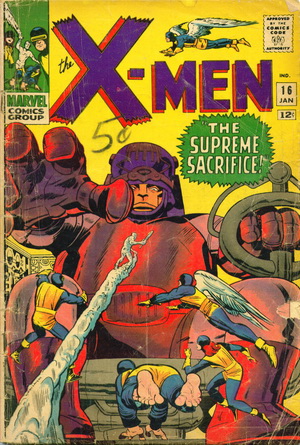
Published: January, 1966
Script: Stan Lee
Layouts: Jack Kirby
Pencils: Jay Gavin
Inks: Dick Ayers
Letters: Art Simek
Russ and I often joke about our “superpowers.” Russ claims he can turn a red traffic light green by staring at it a long time. More impressively, one of mine is the infallible propensity for determining the exact size container for storing leftovers. But—and experience has borne this out—together, our most amazing superpower is the ability to recognize and solve problems—sometimes even before they occur. Life is nothing if not a series of problems that demand solutions. But we have a saying here at Casa Chappell: “Problem?? No problem! Solution!”
Developing a plan for how to store cans in the pantry so you can see them all and don’t have to move them around and risk dropping one on your toes just so you can have a bowl of soup may not rise to the level of a superhero vanquishing a dreaded foe who is hell-bent on taking over the universe, but hey…soup! Right? It’s worth celebrating, in our own little way.
So if we normal human beings, living normal human lives, can be deeply appreciative of the human capacity for developing creative solutions to our normal human problems, how much more is this true for the superhero, who faces exceptionally unique and consequential dilemmas?
This issue of X-Men expertly showcases how these young and still somewhat inexperienced superheroes use both their ordinary and extraordinary skills to get them out of a jar of pickles—without dropping it on their toes! Let’s take a look.
KNOW WHEN TO HOLD ’EM, KNOW WHEN TO FOLD ’EM
In this final installment of a three-part story, the giant robotic Sentinels have captured and imprisoned the X-Men in an impenetrable Heavy Grav Globe. After many attempts at using their superpowers to break out of the globe, the X-Men finally recognize the 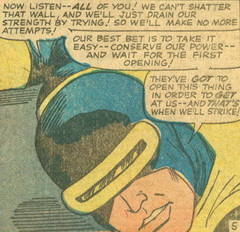 futility of attacking their situation with superpowers, and instead decide on a “Plan B,” which utilizes not only their super-strengths, but also their intelligence and cunning. And as soon as the opportunity presents itself…success! Not to say it’s easy, but the combination of patience, powers, coordination and sheer desperation finally puts them on the other side of the Heavy Grav Globe, fighting and ultimately defeating the Sentinels.
futility of attacking their situation with superpowers, and instead decide on a “Plan B,” which utilizes not only their super-strengths, but also their intelligence and cunning. And as soon as the opportunity presents itself…success! Not to say it’s easy, but the combination of patience, powers, coordination and sheer desperation finally puts them on the other side of the Heavy Grav Globe, fighting and ultimately defeating the Sentinels.
Meanwhile, Master Mold, the leader of the Sentinels, has been repeatedly bullying scientist Bolivar Trask in an attempt to gain his cooperation in creating an even bigger army of Sentinels. Trask refuses several times, but when the Master Mold threatens the destruction of an entire city unless Trask helps, the hapless scientist finally relents, reasoning that “Where there’s life, there’s hope. We may still find a way…” And he holds on to that hope for as long as he possibly can, right up to the last split-second, when he finally determines that hope has indeed run out.
Up until that last moment, it’s reasonable to suspect Trask is only trying to save himself. But eventually he also comes around to his own “Plan B,” putting an absolute end to the technology that produces more Sentinels. This momentous decision results in his own death…but so be it. When there is clearly no other path, he makes this ultimate sacrifice for the good of all mankind.
 Of course this hearkens back to Spock’s Star Trek maxim, “The good of the many outweighs the good of the few.” Trask’s emotional insistence on “hope” is good to a point, but in the end, logic must supersede, even at great personal risk. This is bravery, textbook heroism—and it is this final act that transforms Trask from a well-meaning but misguided adversary into a full-fledged hero.
Of course this hearkens back to Spock’s Star Trek maxim, “The good of the many outweighs the good of the few.” Trask’s emotional insistence on “hope” is good to a point, but in the end, logic must supersede, even at great personal risk. This is bravery, textbook heroism—and it is this final act that transforms Trask from a well-meaning but misguided adversary into a full-fledged hero.
ACHILLES HEEL
Of course, being a hero is always easier, when your foe possesses a glaringly conspicuous Achilles Heel. For all their power, the Sentinels have some major shortcomings. Sticking with our Star Trek motif, in so many ways, they resemble the Borg:  slow moving, individually slow-witted, lacking the capacity for independent thought and creative solutions. Sure, there’s power in numbers, but as in any bureaucracy, numerous nameless minions in an elaborate chain of command does tend to slow things down.
slow moving, individually slow-witted, lacking the capacity for independent thought and creative solutions. Sure, there’s power in numbers, but as in any bureaucracy, numerous nameless minions in an elaborate chain of command does tend to slow things down.
The Sentinel’s most conspicuous Achilles Heel is that they are slow moving. “Whew! Lucky for me they’re so slow moving,” says Cyclops, as he leaps out of the way of a Sentinel’s chest ray. 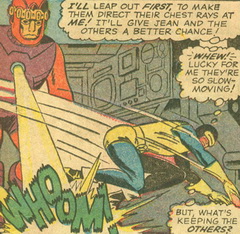 When Marvel Girl turns her powers upon a single Sentinel, she quickly realizes that even a single Sentinel is too much for her telekinetic powers to manipulate. But by using a bit of that good old-fashioned creative problem-solving, she decides instead to focus on only the arms, moving them backwards, which eventually causes the Sentinel to topple over and crash to the ground.
When Marvel Girl turns her powers upon a single Sentinel, she quickly realizes that even a single Sentinel is too much for her telekinetic powers to manipulate. But by using a bit of that good old-fashioned creative problem-solving, she decides instead to focus on only the arms, moving them backwards, which eventually causes the Sentinel to topple over and crash to the ground.
GROWING UP BEFORE OUR VERY EYES
As anyone who’s ever been a parent surely knows, there is a great deal of joy to be had in watching your children learn to figure things out for themselves. As referenced above, there’s quite a bit of that in this story. But wait…there’s more! For instance, Jean uses her powers through a wall. 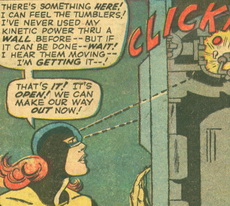 She can’t even see what she’s doing, but somehow gets it done. Necessity is the Mother of Invention? I would add: “Problem…? Solution!”
She can’t even see what she’s doing, but somehow gets it done. Necessity is the Mother of Invention? I would add: “Problem…? Solution!”
Also, Jean helps Angel glide over a fire by lifting him telekinetically, protecting his wings from the flames. This is the first time she uses her powers to levitate both herself and someone else at the same time. Yet another handy application of her powers!
I was somewhat taken aback by Angel inwardly admitting he has always felt superior to the rest of them because he can fly. (Of course, Marvel Girl’s newly developed power to levitate herself is awfully close to flying, isn’t it?) 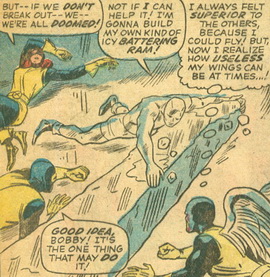 Now, admittedly, any insect that flies is so much scarier than any insect that doesn’t. (Though scampering away at top speed is also disconcerting…) So I can understand why Angel would feel this way about his particular superpower. However, after everything that happens in this issue, I wouldn’t be surprised if Angel now begins to feel differently, to see himself more as an equal to his teammates, rather than above them. (Though, technically, of course, he is often above them…)
Now, admittedly, any insect that flies is so much scarier than any insect that doesn’t. (Though scampering away at top speed is also disconcerting…) So I can understand why Angel would feel this way about his particular superpower. However, after everything that happens in this issue, I wouldn’t be surprised if Angel now begins to feel differently, to see himself more as an equal to his teammates, rather than above them. (Though, technically, of course, he is often above them…)
 Poor Beast is unconscious for a good deal of this story, but once he gets his wits about him again, he utilizes them in a most advantageous manner, carrying the stricken Iceman across his thighs. “There’s more than one way to skin a cat!” he exclaims. Of all the X-Men, I am least surprised that Beast has employed his creative problem-solving skills to resolve an immediate dilemma.
Poor Beast is unconscious for a good deal of this story, but once he gets his wits about him again, he utilizes them in a most advantageous manner, carrying the stricken Iceman across his thighs. “There’s more than one way to skin a cat!” he exclaims. Of all the X-Men, I am least surprised that Beast has employed his creative problem-solving skills to resolve an immediate dilemma.
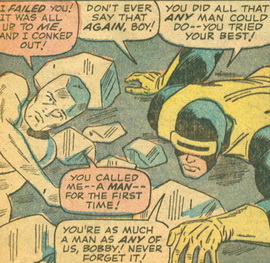 Speaking of Iceman, there’s a lovely moment when he is finally recognized as a “Man” rather than just a boy. His innovative solution to use ice to create pressure to crack the walls of the Heavy Grav Globe ultimately doesn’t work, but it was a good try. When Iceman despairs, “I failed you!” Cyclops prefaces his praise with “Don’t ever say that again, boy!…You’re as much of a man as any of us!” (Ahem? I think Marvel Girl would take exception?)
Speaking of Iceman, there’s a lovely moment when he is finally recognized as a “Man” rather than just a boy. His innovative solution to use ice to create pressure to crack the walls of the Heavy Grav Globe ultimately doesn’t work, but it was a good try. When Iceman despairs, “I failed you!” Cyclops prefaces his praise with “Don’t ever say that again, boy!…You’re as much of a man as any of us!” (Ahem? I think Marvel Girl would take exception?)
Speaking of Cyclops, the fact that he seizes the opportunity to offer positive encouragement to the youngest member of the team expertly illustrates how he is developing his leadership skills. Early in the story, the Narrator describes Cyclops as “the dedicated deputy leader,” but during this crisis, our deputy leader embraces his role more strongly than we have yet seen. I’m reminded of this scene from Avengers, when Captain America rises to his position as leader of the group by employing not only his super-human strength, but also his confident leadership skills to create a plan to succeed against the Chitauri attacking from the skies.
This is such a great moment for the coming together of the Avengers, and I include it here because it so strongly reminds me of the events of this X-Men story. After much individual action and peril, the X-Men all eventually gather together in one spot and Cyclops says, “We’re no safer—no better off—but, at least we’re together!” Developing the ability to cohere together as a team in a healthy manner is also a mark of maturity. All the X-Men are developing individually, but all these individual personal improvements ultimately combine to make them stronger together.
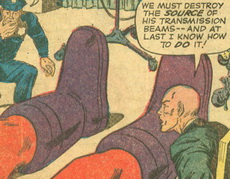 But let’s not stop there! Elaborate problem-solving under intense pressure may still be relatively new for our young X-Men, but Professor X naturally exudes this skill. It’s sort of in his name, Professor X—he’s always thinking. In this issue, the Professor recalls an incident from two issues earlier, when a certain Sentinel was inexplicably incapacitated. Xavier surmises that discovering the answer to this mystery could be their greatest clue on how to take down the whole bunch. Of course, we expect smart and creative thinking from Professor X, but this development also signals a maturing of the level of storytelling, as the events from two issues ago become integral to the resolution of the entire dilemma.
But let’s not stop there! Elaborate problem-solving under intense pressure may still be relatively new for our young X-Men, but Professor X naturally exudes this skill. It’s sort of in his name, Professor X—he’s always thinking. In this issue, the Professor recalls an incident from two issues earlier, when a certain Sentinel was inexplicably incapacitated. Xavier surmises that discovering the answer to this mystery could be their greatest clue on how to take down the whole bunch. Of course, we expect smart and creative thinking from Professor X, but this development also signals a maturing of the level of storytelling, as the events from two issues ago become integral to the resolution of the entire dilemma.
THE GREAT ESCAPE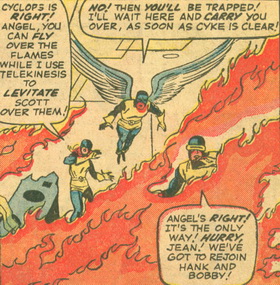
I cannot leave this issue without also noting that the conclusion of this three-part story plays out as cinematic in both scope and execution. The X-Men have defeated the Sentinels, and Trask has sacrificed himself for the good of all humanity. Yet peril still remains: a tremendous wall of fire threatens their lives unless they can find a way to get past it. Working together, each X-Man does their best to save his (or her) comrades. Once again: stronger together!
AND THE MORAL OF THIS STORY IS…
In the last panel, the Narrator summarizes this three-part story with this: “Beware the Fanatic! Too often his CURE is deadlier by far than the evil he denounces!” While this pronouncement is indeed as heavy-handed as it sounds, I will now echo it with my fervent hope that we citizens of 2024 will take this warning to heart and use our own problem-solving skills to evaluate our situation to come up with creative solutions to the many problems we will face in the world today if we don’t “beware” the fanatics, grow up, get over ourselves and learn how to cooperate. We may not have the superpowers of the X-Men, but if we employ their same level of loyalty and unity against our current quandaries, surely we can make this world a better place.
Sermon over. The Mass has ended. You may now go in peace, to contemplate how lessons learned in Marvel Comics might mirror and improve our lives…if only we keep ourselves open to the challenge of solving problems by seeking out creative solutions.
| Want to read this comic on your computer? Marvel has a scan! Want to own the story? Buy the Masterworks! |














